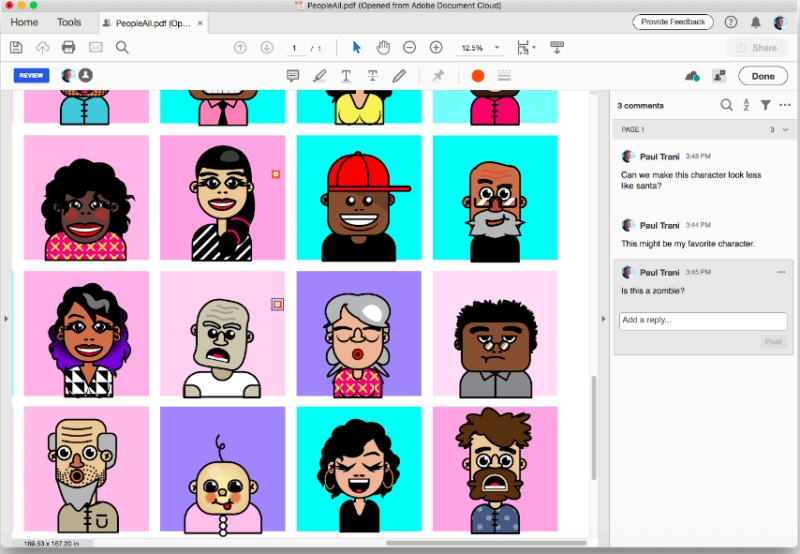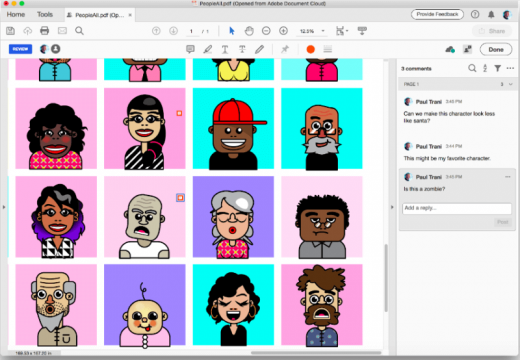Adobe makes its venerable PDF more collaborative
Online commenting and live chat can now replace the frustrating email attachments, plus you can keep track of the review process.

If you can remember back to the time in the last century before Adobe launched its PDF, software-constructed documents were fickle things that acted differently in different devices and screens.
With PDFs, marketers — among others — could issue press releases, white papers, printable surveys, case histories and many other documents, confident that users would see the same document that had been created. In the last year alone, Adobe said, more than 200 billion PDFs were created worldwide.
But even static document formats need to be updated occasionally, and Adobe is announcing several key changes on Tuesday, moving the format further along the path toward becoming a live — but frozen when desired — document.
The new enhancements, Product Marketing Manager Lisa Croft told me, are “radically transforming what’s possible with PDFs.”
A new review process. The biggest change: an all-new version of Acrobat DC (Document Cloud) now has a sensible content review process, an attempt to fix PDF’s biggest weak spot. As Adobe Senior Creative Cloud Evangelist Paul Trani describes in his blog post:
If you’re like me, you usually create a PDF of your work in Acrobat and send it out to clients, managers and colleagues as an attachment, or a link in an email. What happens next is typically a mix of pain and agony that gets exponentially worse as you add more reviewers — managing versions and reconciling conflicting feedback [as comments on the PDF] through email and reminding people to open, review and get back to you with their thoughts.
Instead of circulating a PDF document via email for comments, with someone having to synthesize the proposed changes while avoiding a nervous breakdown, the document now remains online, where it collects comments from invited reviewers, provides automatic reminders about deadlines and offers a live chat window. You can’t see the other edits happening live in real time, as with a Google Doc, but you see a message about incoming comments each time the PDF is updated. Here’s a screen shot of a creative PDF in review:

A new role for Sensei. Sometimes, a PDF is sent out and the recipient has to print it in order to enter text into fields that have not been designated by the document creator as capable of receiving input.
But now Adobe’s AI layer Sensei can recognize when a field on an online PDF should be able to accept text input, so the new PDF lets a user enter text in those fields, even if the PDF creator didn’t so designate the field. If the creator really doesn’t want Sensei to allow text, the AI sensing can be turned off.
Home page, Android tablet editing, updated Sign. The Home page for Acrobat and Reader now acts as a central hub with status updates for tasks and for outstanding shared PDFs, such as where a given PDF is in a review cycle. Previously, Home just listed documents.
Acrobat Pro DC now allows full, touch-enabled desktop-level editing functionality for users on Android tablets, a mobile capability previously available only on iOS tablets.
And the new versions of Acrobat DC and Reader DC now have Adobe Sign built in, for electronic signatures. Before, Sign’s availability was more limited.
Why this matters to marketers. PDFs have become workhorses for marketers, acting as the format of choice for printable and distributed brochures, white papers, creative treatments of ads and countless other marketing material.
These functions have required the documents to act as vehicles for review by team members, although that function has been particularly clunky. It’s surprising Adobe has taken this long to turn the PDF into a fully reviewable online and collaborative document, but the new capability could improve the quality of life for marketers, designers and art directors everywhere.
This story first appeared on MarTech Today. For more on marketing technology, click here.
Marketing Land – Internet Marketing News, Strategies & Tips
(41)



